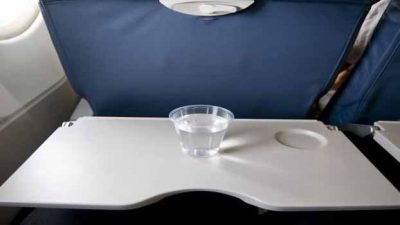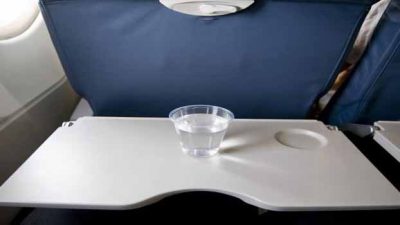What’s in the Water You’re Sipping on that Flight? Diet Detective Tells All
Not all water served in the air is fit to be sipped, according to new study by Hunter College and Diet Detective
September 9, 2019

The quality of drinking water varies by airline, and many airlines have possibly provided passengers with unhealthy water, according to a 2019 Airline Water Study released today by DietDetective.com and the Hunter College NYC Food Policy Center.
Unhealthy water violates the federal government’s Aircraft Drinking Water Rule (ADWR) implemented in 2011 that requires airlines to provide passengers and flight crew with safe drinking water.
“Alaska Airlines and Allegiant win the top spot with the safest water in the sky, and Hawaiian Airlines finishes No. 2,” said Charles Platkin, PhD, JD, MPH, the executive director of the Hunter College NYC Food Policy Center.
The airlines with the worst scores are JetBlue and Spirit Airlines, the study shows.
“Except for Piedmont Airlines, regional airlines need to improve their onboard water safety,” Platkin said.
The ADWR requires airlines to take samples from their water tanks to test for coliform bacteria and possible E. coli. Airlines are also required to disinfect and flush each aircraft’s water tank four times per year. Alternatively, an airline may choose to disinfect and flush once a year, but then it must test monthly.
The 2019 Airline Water Study also found that the Environmental Protection Agency – one of the federal agencies responsible for ensuring safe aircraft drinking water- rarely levies civil penalties to airlines in violation of the ADWR.
The 2019 Airline Water Study ranked 11 major and 12 regional airlines mainly by the quality of water they provided onboard flights. Each airline was given a “Water Health Score” (5 = highest rating, 0 = lowest) based on 10 criteria, including fleet size, ADWR violations, positive E. coli and coliform water sample reports and cooperation in providing answers to water-quality questions. A score of 3.0 or better indicates that the airline has relatively safe, clean water.
The study found:
• The major airlines receiving the highest Airline Water Health Score are Allegiant and Alaska – each with a score of 3.3 on a 0-to-5 scale. Hawaiian Airlines is a close second at 3.1.
• Piedmont Airlines, which operates American Eagle flights, is the highest-rated regional carrier with a score of 4.33.
• Among major airlines, Spirit and JetBlue tied for the lowest score of 1 on a 0-to-5 scale.
• Nearly all regional airlines, except Piedmont, earned poor Water Health Scores and a large number of ADWR violations. Republic Airways (which flies for United Express, Delta Connection and American Eagle) has the lowest score at 0.44 on a 0-to-5 scale and ExpressJet is second-lowest at 0.56. ExpressJet averages 3.36 ADWR violations per aircraft.
•The number of ADWR violations by all airlines in 2018 was significantly less than the number in 2012, the first year after the ADWR was enacted. For major airlines, violations have decreased 69% (262 to 81), while violations among regional airlines have decreased 71% (351 to 103). However, the decrease might reflect a lack of enforcement by the EPA, which has issued few penalties in recent years.
• The “Shame on You” Award goes to the EPA and nearly all major airlines (regional airlines weren’t contacted) for their very poor response time and lack of cooperation answering detailed questions. The EPA didn’t answer most penalty-related questions, and Spirit, Allegiant and Frontier did not respond to any questions. Very weak responses – and responses that didn’t address questions – were provided by American, United, and JetBlue, which had a large number of violations during the past seven years.
Testing for coliform bacteria is important, because their presence in drinking water indicates that disease-causing organisms (pathogens) could be in the water system. When an aircraft’s water sample tests positive for coliform, it must be tested again to determine if E. coli is present. Even if E. coli is not present, the airline must still take repeat samples within 24 hrs, and disinfect and flush the water system within 72 hrs. The airline can also shut down the water system within 72 hrs and then disinfect and flush. If the sample is E. coli positive, the airline must shut off public access to the water system within 24 hrs and disinfect and flush.
The ADWR does not require the same testing as the National Primary Drinking Water Regulations, which includes other microorganisms in addition to total coliform. An aircraft flies to numerous destinations and may pump drinking water into its tanks from various sources at domestic and international locations. The water quality onboard also depends on the safety of the equipment used to transfer the water, such as water cabinets, trucks, carts and hoses.
Advice: To be extra safe …
•
o NEVER drink any water onboard that isn’t in a sealed bottle
o Do not drink coffee or tea onboard,
o Do not wash your hands in the bathroom; bring hand-sanitizer with you instead.
Scores (5 = highest rating, 0 = lowest):
Alaska Airlines: 3.3, Allegiant Air: 3.3, Hawaiian Airlines: 3.1, Frontier Airlines: 2.6, Southwest Airlines: 2.4, Delta Air Lines: 1.6, American Airlines: 1.5, United Airlines: 1.2, JetBlue: 1, Spirit Airlines: 1
Regional Airlines:
Piedmont Airlines: 4.33, Sun Country Airlines: 2.78, Envoy Air: 2.11, GoJet Airlines: 2, Trans States Airlines: 1.78, Compass Airlines 1.22, PSA Airlines: 1.22, SkyWest Airlines 1.11, Endeavor Air: 0.78, Air Wisconsin Airlines: 0.68, ExpressJet Airlines: 0.56, Republic Airways: 0.44




